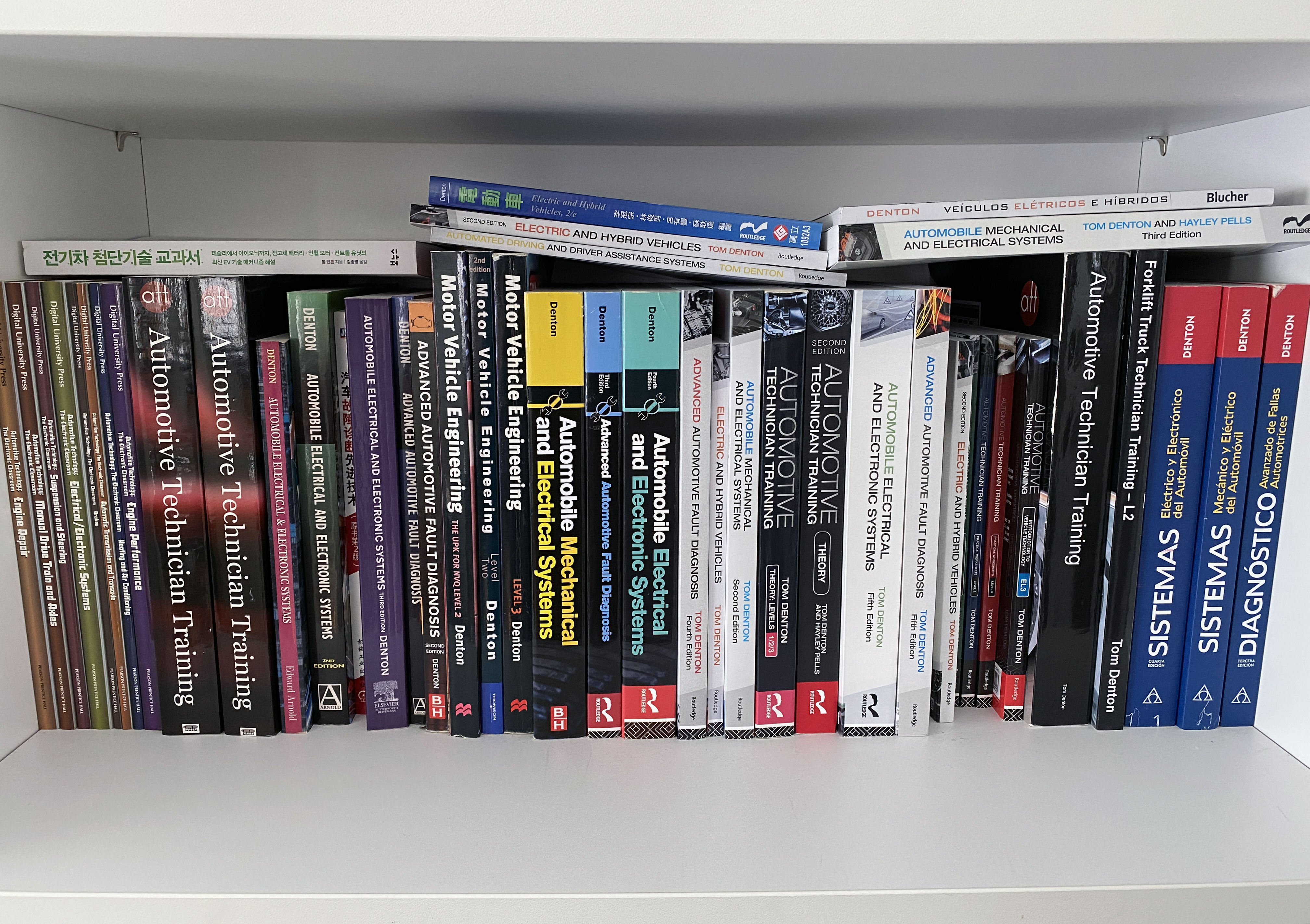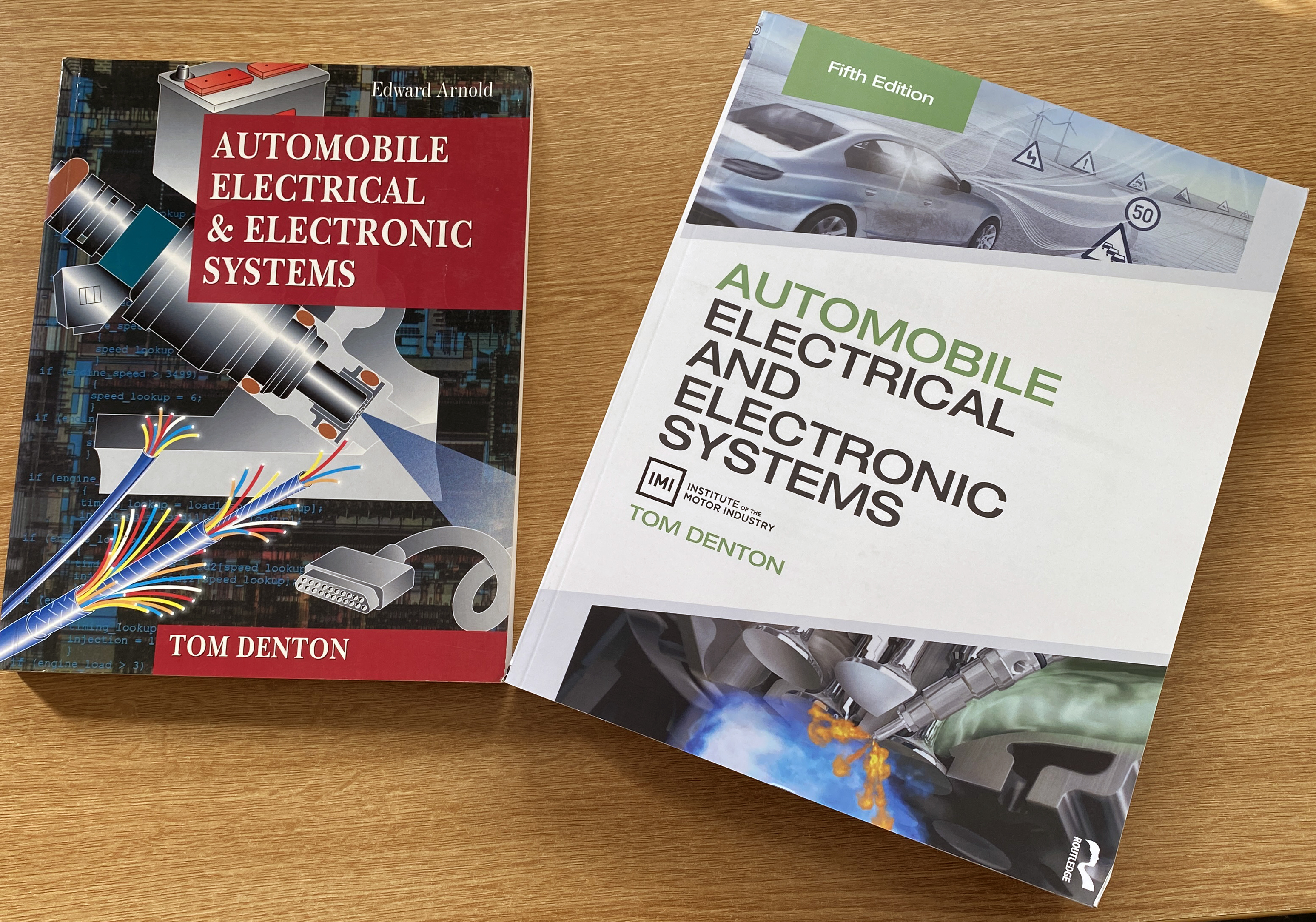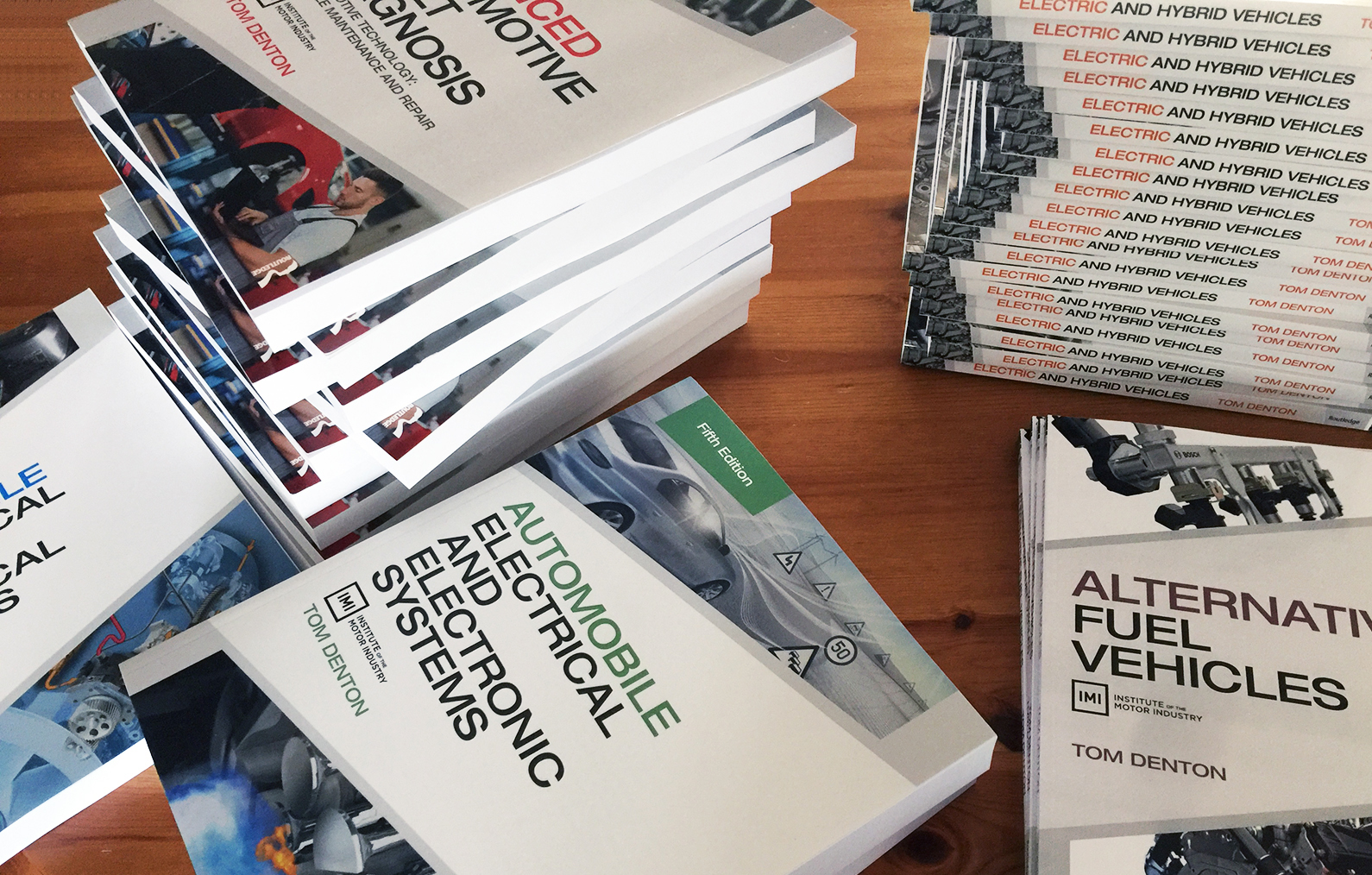Paperback writer
End of a chapter
Writing and publishing textbooks is something I never thought I would do. Yet here I am with my 45th book now published, which will be my final textbook. This book is the third edition of Hybrid and Electric Vehicles, written in partnership with my colleague and friend Hayley Pells.
** Books for sale here - signed and free delivery: Automotive Technology **
Quite a step from failing my English 'O' level with a grade 8 – which at that time meant something like absolutely useless and this boy will never write anything useful. I hope you will indulge me by reading about my career and how I did manage to write something.

Figure 1 My shelfie...
Where and when did it all start?
Way back in time when most TVs were still receiving black and white!
I have been involved in automotive engineering for a very long time. I'd argue that my interest started some 55 years ago when I was about ten and I 'helped' my dad fix his Lambretta scooters. When it was very cold, we would do this inside the house, much to my mum's displeasure!
I graduated to fixing up my own bicycles and then motorbikes. I took as many technical subjects as I could at school. Metalwork, technical drawing and design were my favourite. A big shout out here to my teacher of these subjects, Mr Whiteley, who definitely had an important and positive influence on my career – he was probably right too when he said I should complete my A levels and not leave halfway through to join the army.
I left school halfway through my A levels and trained as a soldier and auto-electrician in the Royal Electrical and Mechanical Engineers (REME). The technical training was amazing and even covered high voltage. It just goes to show that when you learn something, you never know that it could become really useful in the future. I loved my time in the army including some active service but, further than gunpowder will blow you and all that, I left the army in 1981 when I got married.
At this time I started my own small business doing mobile auto-electrical work. This was mostly for garages because even back then, most technicians didn't like electrical work. Several years later I was in partnership with two others and we had a high street garage. Any fool with hindsight and all that, but if I had one regret in my career, it was having a partner at this time – perhaps I chose badly. Nonetheless, it was mostly a great time and of course the experience stacks up. One Sunday morning while taking a starter motor off a tar spraying truck, with oil dripping in my eyes, I decided it was time for a change. I started studying with the OU (completing a degree and a certificate in education several years later). I left the garage business with all my tools in tow, and I still have them.
At this time (about 1989) I started work as a lecturer in the FE college in Colchester, teaching mostly automotive electrical and electronic systems. I absolutely loved it. A few years into this, a commissioning editor from a publisher known as Edward Arnold at that time (now Routledge) visited the automotive staff room and said he was looking for somebody to write a book on automotive electrical and electronic systems. Having always suffered from volunteering before thinking things through I, well, volunteered. I started work in 1992 and in 1995 my first book, Automobile Electrical and Electronic Systems, was published. To say I was proud was an understatement! The fifth edition of this book was published 23 years later in 2018.

Figure 2 First and fifth editions – 23 years apart
I stayed in FE teaching for about 12 years ending up as Head of Automotive and Fabrication. After this I worked as a consultant for a while, joined an eLearning company, worked as a Staff Tutor for the OU and again really enjoyed the range of experiences. I continued to write automotive textbooks of course.
Long story short but the eLearning business was sold to the IMI and I went with it and worked as their eLearning manager. I absolutely loved it but the lure of being my own boss was still there so I left after three years and worked as a consultant, including for the IMI, and of course kept writing books!
So, here we are now, pretty much up to date; and it is time for another change. I have decided that, after completing what will be my 45th textbook, I'm putting down my 'pen' (keyboard!) and handing over the reins. Before I do this, allow me to answer a question I am often asked.
How do you write a textbook?
This question is often asked in two parts.
First: How do you get all the information? The answer to this question is that there is no magical method. I attend as many events as possible, talk to people, listen to presentation and generally take in as much as possible and make contacts – networking if you like. I also buy lots of books and papers that are published by engineers and academics working on developing new automotive systems. This information can then be distilled into an accessible format for my books. There is of course an element of standing on the shoulders of giants as Isaac Newton is said to have written!
Second: Where do you start? It can be daunting starting to write a textbook that has a target of up to 100,000 words. But best not to dwell on that part too much. My method has a number of descriptions ranging from Hierarchical Task Decomposition to Outlining. In simple terms, this means splitting the big job into lots of little ones!
I start by listing and numbering the chapters:
Chapter 1 Introduction, Chapter 2 Basic electrics, Chapter 3 Tools and equipment etc. Then each is split into topics so that chapter 2, for example, could include:
2.1 What is electricity, 2.2 Circuits, 2.3 Units, and so on. These topics can then be split into sections so that Chapter 2, Topic 2.1, could include:
2.1.1 Structure of the atom, 2.1.2 Electron flow, 2.1.3 Conventional flow etc.
If necessary sub-sections (2.1.1.1) or even sub-sub-sections (2.1.1.1.1) can be used as a guide to the content, and if appropriate their headings can be deleted later.
This process of outlining is quite a big job but it does then mean there are now a number of more easily manageable tasks – in fact, quite a large number. These chapters, topics, sections and sub-sections can all be edited and moved around later so getting the exact titles and order at an early stage is not that important.
All we now need to do is fill in the text and images for each section or sub-section. And that's it!
Well not quite. The completed document goes to an editor who will make suggested changes to the grammar, fix the typos, make sure figures are referenced and check that the books is accessible to the intended readers. I make these changes to the manuscript. And that's it!
Well not quite. The text and images are now typeset into the final book format and this is returned for any final edits and corrections. Better quality images are often requested at this stage too. And that's it!
Well not quite. The final page proofs are returned for the index to be created. Actually not me, I tricked Hayley into doing this for the last few books. And that's it!
Well not quite. We then send in text, images and suggestions for the cover and the marketing blurb. And that's it!
And yes, this time it really is it! We sit back and wait for the first copies of the book to land on the mat. Getting these is definitely the best bit.

Figure 3 My stock of textbooks
After all this work, one thing that can be really nice, or in some cases quite hurtful, is the book comment option on amazon. I am glad to say by far the majority have been in the 'really nice' category.
Book reviews
I have two favourites: The first is one is really a combination of many I have received where a student will say how much one of my books helped them with their learning – and give me five stars. This is amazing because it is why I started writing in the first place.
My second favourite was from a DIY mechanic who, after getting a book, said 'this book is rubbish because I couldn't fix my car'. He then helpfully pointed out that I had clearly stated: 'Don't buy this book to fix your car because it is not aimed at amateurs'. But I still only got one star!
Finally, what next?
I have really enjoyed my automotive career, which has encompassed all aspects of our trade. Even taking that starter off the tar tanker was a good job. I stripped it down, cleaned it up, repaired or replaced its components, refitted it to the vehicle and of course it started first go – so I wrote them an invoice.
I'm not going anywhere and will still be doing some part-time work, especially for the IMI. One aspect of this work is for me to develop an 'Author Training' course. Contact the IMI if this is something you would be interested in.
Music has always been a part-time hobby and now I can spend more time on it. I play the keys in a covers band (www.tomdenton.org/music) and it is enormous fun. I guess as well as being and old paperback writer - I am becoming an old rocker playing Paperback Writer!
Tom Denton BA, FIMI, MSAE, MIRTE, CAE, Cert. Ed
www.tomdenton.org